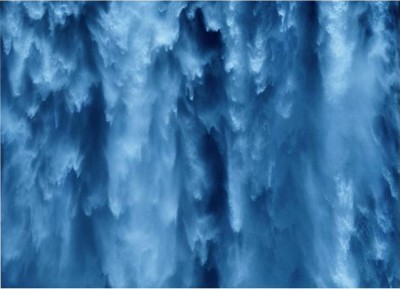Decadence and Dark Dreams
Belgian Symbolism
Alte Nationalgalerie, Berlin
Through 17 January 2021 - Temporaly closed
All museums of the Staatliche Museen zu Berlin are closed. No exhibitions or events will take place until further notice.
Caresses, 1896
Oil on canvas, 50 × 150 cm
© Musées royaux des Beaux-Arts de Belgique, Brüssel
The sensual gaze of a jaded society on the brink of the abyss, the morbid attraction of Thanatos and Eros: these are subjects in art which found expression at the end of the nineteenth century, particularly in Belgian Symbolism. The large-scale special exhibition “Decadence and Dark Dreams”, with over 180 works in the Alte Nationalgalerie, is dedicated to this artistic trend that emerged in the 1880s with Brussels as a major centre.
The Flowers of Evil, 1891
Oil on canvas, 81 x 58 cm
Private collection, Genf
Belgian Symbolism is characterised by a special predilection for morbid and decadent themes. Death and dissipation were recurring motifs even around the middle of the century, and can be traced back to sculptors such as George Minne and that master of the absurd, James Ensor. Inspired by contemporary literature, the artists around 1900 were linked by a new mysticism with an extravagant and sumptuous style. In this context the femme fatale became a central figure as an expression of over -abundance and lust. Symbolism, however, did not just influence portraiture and figure painting, but was also reflected in landscape painting and eerie interior scenes.
The Love of Souls, 1900
Oil and tempera on canvas, 238 × 150 cm
© Musée d’Ixelles – Brüssel, Photo: Vincent Everarts
The extensive special exhibition with over 180 works on loan from international collections and Belgium’s most important museums, including Antwerp, Brussels and Ghent, introduces the entire spectrum of Belgian artistic positions previously little-known in Germany – like Fernand Khnopff, Léon Spilliaert, Félicien Rops, James Ensor and Jean Delville – as an important reference for Symbolism. Of special note, from the Royal Museum of Fine Arts in Brussels, is Fernand Khnopff’s sphinx -like “The Caresses”: an absolute icon of Belgian Symbolism. Works by artists such as Max Klinger, Edward Burne-Jones, Arnold Böcklin, Edvard Munch, Gustave Moreau and Gustav Klimt allow placement within the broader European context.
WILLIAM DEGOUVE DE NUNCQUES
Child with Owl, 1892
Pastel on paper mounted on canvas, 41 x 35 cm
Privatsammlung, Antwerpen
© Private collection, courtesy Van Herck – Eykelberg, Antwerp
List of Belgian Artists of the Exhibition
Arthur Craco (1869-1955)
William Degouve de Nuncques (1867-1935)
Jean Delville (1867-1953)
Charles Doudelet (1861-1938)
Paul Dubois (1859-1938)
James Ensor (1860-1949)
Henri Evenepoel (1872-1899)
Émile Fabry (1865-1966)
Léon Frédéric (1856-1940)
Henry de Groux (1866-1930)
Fernand Khnopff (1858-1921)
Eugène Laermans (1864-1940)
Georges Le Brun (1873-1914)
Xavier Mellery (1845-1921)
Charles Mertens (1865-1919)
George Minne (1866-1941)
Constant Montald (1862-1944)
Émile Motte (1860-1931)
Jean-François Portaels (1818-1895)
Félicien Rops (1833-1898)
Victor Rousseau (1865-1954)
Juliette Samuel-Blum (1877-1931)
Léon Spilliaert (1881-1946)
Charles van der Stappen (1843-1910)
Théo Van Rysselberghe (1862-1926)
Other Artists of European Symbolism of the Exhibition
Isle of the Dead, 1883
Oil on panel, 80 x 150 cm,
Staatliche Museen zu Berlin, Nationalgalerie
© Staatliche Museen zu Berlin, Nationalgalerie,
Photo: Andres Kilger
The Sin, um 1912
Oil on canvas, 88 x 52,5 cm
Staatliche Museen zu Berlin, Nationalgalerie
© Staatliche Museen zu Berlin, Nationalgalerie,
Photo: Andres Kilger
Arnold Böcklin (1827-1901)
Edward Burne-Jones (1833-1898)
Georges de Feure (1868-1943)
George Frampton (1860-1928)
Vilhelm Hammershøi (1864-1916)
Ferdinand Hodler (1853-1918)
Albert von Keller (1844-1920)
Gustav Klimt (1862-1918)
Max Klinger (1857-1920)
James McNeill Whistler (1834-1903)
Edvard Munch (1863-1944)
Gustave Moureau (1826-1898)
Odilon Redon (1840-1916)
Dante Gabriel Rossetti (1828-1882)
Carlos Schwabe (1866-1926)
Franz von Stuck (1863-1928)
Jan Toorop (1858-1928)
Originally planned to run from 15 May until 13 September 2020, the exhibition has been postponed due to the museum’s Corona virus related closure.
The exhibition is supported by the Royal Museums of Art in Belgium, and made possible by the Freunde der Nationalgalerie.
An extensive catalogue has been published by the Hirmer Verlag:
Decadence and Dark Dreams. Belgian Symbolism
336 pages, 265 colour illustrations
24,5 cm x 29 cm, hardcover
Edited by Ralph Gleis, with contributions by
J. Block, M. Brodrecht, Y. Deseyve, J. De Smet,
M. Draguet, R. Gleis, A. Groenewald-Schmidt,
H. Körner, I. Rossi.
ALTE NATIONALGALERIE
Staatliche Museen zu Berlin
Bodestrasse 1-3, 10178 Berlin























